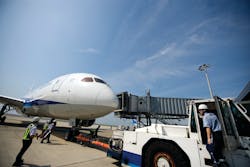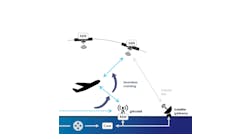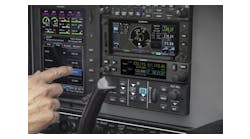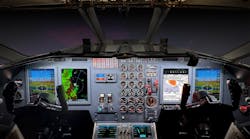Earlier in the year at the Farnborough International Air show aviation enthusiasts had the opportunity to see showcased for the first time the Airbus 350 which a few weeks before had taken off from Toulouse on its maiden flight and is due to go in service by the end of the year with Qatar Airways.
One of the peculiarities of the A350 is that more than half of it is made out of composite materials. The same holds true for the other large airplane of its generation, the Boeing 787. By contrast, earlier Boeing and Airbus aircraft are approximately 10 to 15 percent built of composite materials in terms of their total structural weights. The A380 – launched in the early 2000s as the first aircraft made of lightweight material – is approximately 20 to 25 percent made of composites.
RAISING CONCERNS
The fact that composite materials are becoming increasingly important in aircraft manufacturing raises some concerns in the ground support community because of specific ‘behavioural’ properties of these materials when impacted by ground support equipment.
In September 2011, the U.S. Government Accountability Office released a report on the “status of the FAA’s actions to oversee the safety of composite airplanes” (GAO-11- 849 Aviation Safety). The report highlighted the challenges in detecting and characterizing damage in composite structures, as well as making adequate composite repairs.
Most notably, the report also said the impact damage to composite structures is unique in that it may not be visible or may be barely visible, making it more difficult to detect than damage to metallic structures. As a result, safety occurrences may result as a consequence that the defects of composite material surfaces can be missed during daily and weekly checks. A simple ‘tap’ test might not detect delaminations at early stages or in specific areas.
Most aviation personnel – including ground crews – are capable of identifying a dent or a tear in a metallic structure, and reporting it as suspect damage. However, after a heavy impact, a composite structure could appear undamaged if no surface marks or flaws are present. And where they are present, they may go unreported due to having a similar appearance to small dents on a metallic structure, which ground crews may be inclined not to report, states Lawrence Cook in “Visual Inspection Reliability For Composite Aircraft Structures.”
There is concern that ground crews, as well as maintenance technicians and pilots, may be less experienced at recognizing impact damage on a composite aircraft structure. This could lead to a situation where damage is not reported and is, subsequently, not repaired. In addition, the reliability of detecting surface flaws in composite structures is not well-established, which further means that significant damage may not be reported, according to Cook.
DETECTION RECOMMENDATIONS
What can be done from an operational point of view to facilitate composite damage detection on the ramp especially in the years to come when more and more composite built aircraft will enter into service?
The European Aviation Safety Agency commissioned a research project entitled “Composite Damage Metrics and Inspection” which was issued in 2012 and authored by consultants Zoltan Mikulik and Peter Haase. The report contains three recommendations providing useful guidance in the operational aircraft ground handling environment.
- Preventing impact: The first operational recommendation is to improve on preventing undue impact.
“A contact between ground service vehicles and the fuselage is mainly protected by passive safety devices (such as rubber bumpers)," reads the report. "Although modern ground service vehicles feature several types of electronic safety systems like proximity sensors and automatic position adjustment, there are no safety regulations that would require these systems to be fitted in vehicles involved in aircraft ground operations. Standardization of the safety systems is necessary to reduce the impact threat.”
- Monitoring systems: A related recommendation deals with improved performance monitoring of GSE operations.
“Ground service vehicles, which repeatedly make contact with the fuselage, such as mobile stairs and cargo loaders," reads the report, "might be fitted with monitoring and assistance systems that would provide better visibility and assessment of the vehicle’s movement within a specified distance from the fuselage. Recording of sensor and camera data might support the complete reporting of incidents and their investigation.”
- Reporting damage: A third recommendation concerns improving ground damage reporting.
“Based on the proven differences in detecting damages between metallic and composite fuselages, the reporting processes should cover every inadmissible contact to evaluate all potential safety risks," reads the report.
Although ground service personnel are trained to follow the "report every vehicle contact” policy, the EASA report also points that incident reporting typically relies strongly on visual examination of the outer skin structure, and states that the rate of vehicle contact reporting is approximately 50 percent.
"Due to a lack of visually evident damage," the report adds, "this rate can even further reduce for composite hulls if vehicles are not equipped with modern active safety systems."
TRAINING PERSONNEL
Training ramp personnel to locate key composite structures on specific aircraft is a very significant part to improving ground damage reporting. With metallic structures, the need of reporting a collision event is straightforward. A hit surface does or does not look damaged and, therefore, is or is not damaged,
But there's much more complexity when reporting when a composite surface is hit. In such circumstances, there is a need to report that a structure is hit irrespective of whether ramp personnel believe it is damaged or not.
It should be kept in mind that the time lapse from the collision event to the actual reporting of the accident may also significantly affect detectability of damage.
“Some damaged structures may relax, e.g. impact damage, to the extent that 60 percent or more, of the original profile may be recovered," reports the UK CAA Civil Aviation Publication 562 “Civil Aircraft Airworthiness Information and Procedures.”
After the reporting of a collision event, the suspected damaged surface needs to be inspected to assess whether there is or isn't sub-surface damage.
NDT
Aviation Safety and Quality Consultancy GEDA of Italy provides guidance on the various techniques available for non-destructive testing (NDT) of composite surfaces.
“Due to the anisotropic nature of composites, whose characteristics depend on the direction along which they are considered, the identification of damage requires NDT techniques to be carried out by qualified personnel according to EN4179 standard (under EASA) or in accordance with MIL-STD-410 (under the FAA),” affirms GEDA.
These techniques are based on different methodologies.
One methodology is optical. As such it implies the visual observation of a component, possibly with the use of a lens. Advanced methods include the reflection of a light wave, holographic techniques and interferometry.
Another methodology is based on the use of penetrating liquids. This implies that an inspection can locate open surface discontinuities and "take advantage of the ability of some liquids to penetrate by capillarity in the cavities or emerging cracks,” reports the GEDA.
If the composite is electrically conductive, another applicable technique is based on the use of eddy currents.
“A sub-surface control is made with a probe where an alternating current passes through, and it produces eddy currents by electromagnetic induction," says the GEDA. "This technique allows detecting the presence of defects located below the outer surface of the component under inspection.”.
Additional NDT methodologies available include radiography, thermography and acoustic techniques.
Through radiography it is possible to have a detection of defects, voids, or the presence of foreign materials up to tens of centimeters in depth. On the actual radiography the irregularities are presented with a different density than the material that surrounds them.
Through thermography, thermal imaging with infrared thermo-cameras detect the temperature of the bodies analysed. Defects correspond to changes in temperature. "Thermography is aimed to the analysis of thermo-elastic stresses, for improvements in the design of components, and it views and measures the voltages in components under stress, thereby identifying a possible initiation of cracks,” reports the GEDA.
Through acoustic techniques the defects which are present in the material - for example, cracks and/or debonding - are detected by means of ultrasonic signals generated by a suitable probe or by means of acoustic signals generated manually by the operator, according to the GEDA.
With acoustic methods, there exists a particular instrument called a ramp damage checker, which is available from Olympus and is a hand-held ultrasonic instrument designed for preliminary screening of aircraft composites to identify areas of possible subsurface impact damage, but not to substitute for comprehensive testing by a trained inspector.
“Ultrasonic sound waves travel through materials in a predictable way," reports Olympus. "When a high frequency sound pulse generated by an ultrasonic transducer is coupled into a piece of solid laminate composite, it will travel through the material until it encounters an air boundary, at which point it will reflect back as an echo that can be detected by a gauge.
In the case of structurally solid composite, that reflection will come from the backwall or the inside surface of the laminate. If, however, there is a delamination or subsurface cracking parallel to the surface, then the reflection will come instead from the damaged area and arrive earlier in time.
"The difference in the echo patterns from good versus damaged material can be used to identify areas of internal damage that are not visible from the surface,” reports Olympus.
The ramp damage checker is not intended to scan large areas, and is used to screen areas of suspected damage.
The device must first be calibrated for the specific thickness of material that is to be tested and, as such, it must always be recalibrated whenever switching to an area of different thickness or different material. The device features a backlit LCD that displays the word GOOD if no subsurface damage is found or the word BAD when it detects subsurface damage. Any BAD indication should be investigated further.
An additional internal "safety barrier" complements the device: the gauge displays BEYOND CAL THICKNESS when only a strong backwall echo is received, but it is beyond the calibration window.
About The Author: Mario Pierobon holds a Master’s Degree in Air Transport Management from City University London and works in business development and project support at Great Circle Services in Lucerne, Switzerland. Mario regularly writes about aviation safety and his main professional and research interests are in the areas of airside safety.




